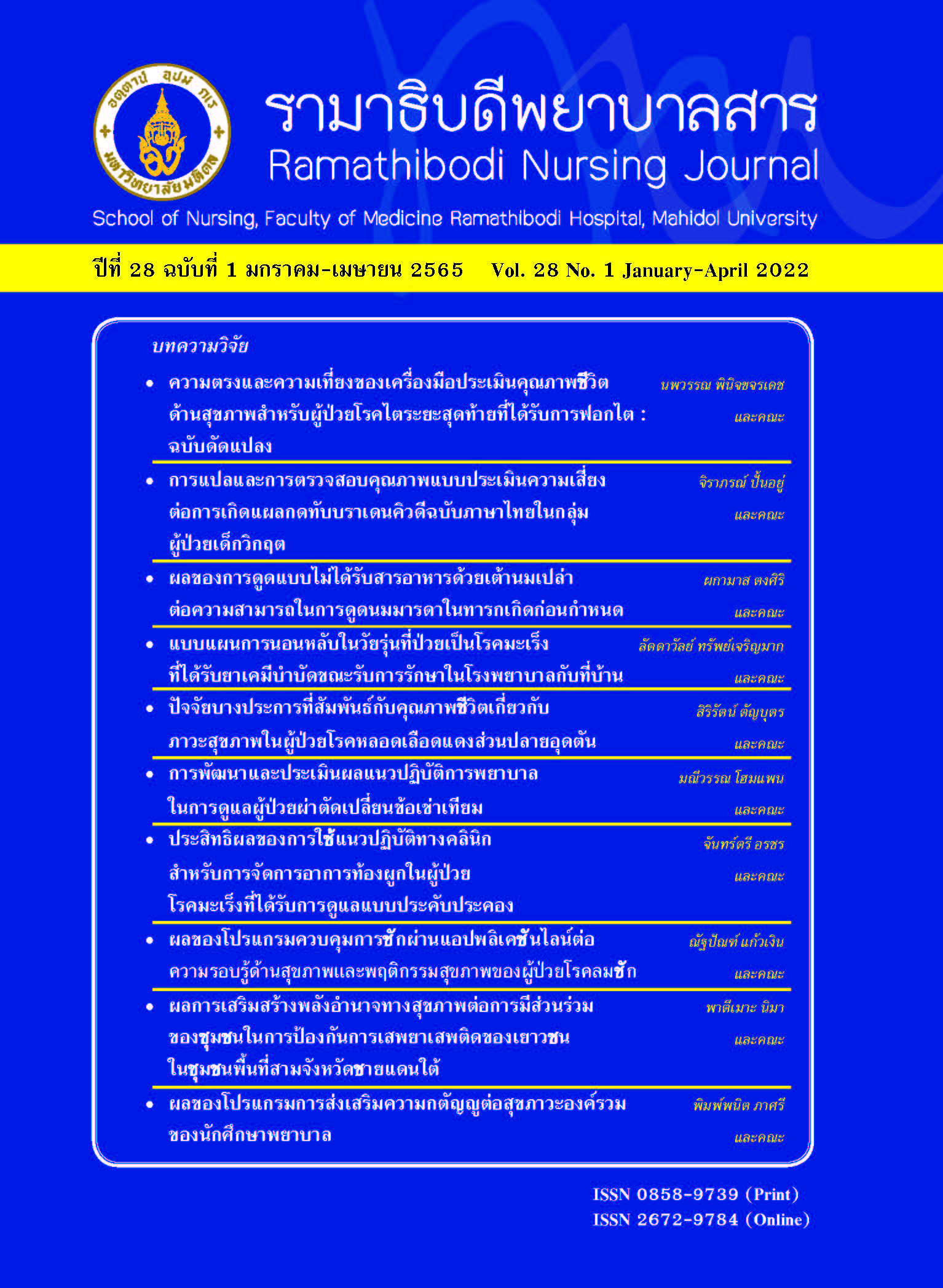Validity and Reliability of the Health-Related Quality of Life Instrument for End Stage Renal Disease Patients undergoing Dialysis: A Modified Version
Main Article Content
Abstract
This study aimed to modify and test the validity and reliability of the Thai Health-Related Quality of Life Instrument for Dialysis Patients (THAI-HRQOL-D),developed by the researchers in 2012. The sample for testing the validity and reliability of the instrument consisted of 244 participants undergoing dialysis (185 hemodialysis
and 59 peritoneal dialysis patients) who attended four dialysis centers in the eastern region of Thailand. The construct validity of the instrument was determined through exploratory and confirmatory factor analyses and the known-groups technique. Also,Cronbach’s alpha coefficients were used to test the internal consistency reliability of the instrument. The results yielded seven factors and explained 52.89% of the variance.These seven factors, consisting of 34 items, included health and functioning, living with symptoms, living with dialysis, socioeconomics and family, spirituality, psychological
well-being, and cognition. Through the confirmatory factor analysis, the adequate relative goodness of fit indices revealed that the measurement model fit the data. The internal consistency reliability, measured by Cronbach’s alpha coefficients, was good. The known-groups technique revealed that participants with a normal level of hematocrit
and serum albumin had a significantly higher mean score of the THAI-HRQOL-D than those with a low level. This study demonstrated that this disease-specific instrument has adequate validity and reliability to assess health-related quality of life among dialysis patients.
Keywords: Health-related quality of life instrument, Validity, Reliability, End stage renal disease patients undergoing dialysis
Article Details

This work is licensed under a Creative Commons Attribution-NonCommercial-NoDerivatives 4.0 International License.
บทความ ข้อมูล เนื้อหา รูปภาพ ฯลฯ ที่ได้รับการตีพิมพ์ในรามาธิบดีพยาบาลสาร ถือเป็นลิขสิทธิ์ของวารสาร หากบุคคลหรือหน่วยงานใดต้องการนำทั้งหมดหรือส่วนหนึ่งส่วนใดไปเผยแพร่หรือเพื่อกระทำการใด ใด จะต้องได้รับอนุญาตเป็นลายลักษณ์อักษรจากรามาธิบดีพยาบาลสารก่อนเท่านั้น
References
เอกสารอ้างอิง
Nephrology Society of Thailand. Anual report Thailand renal replacement therapy 2020. Bangkok: Nephrology Society of Thailand; 2021. (in Thai)
Kanjanabuch T, Takkavatakarn K. Global dialysis perspective: Thailand. Kidney360. 2020;1:671-5.
National Health Security Office. NHSO anual report 2020.Bangkok; 2021. (in Thai)
Tiansaard J, Chaiviboontham S, Phinitkhajorndech N.Perception of symptom burden, financial burden, and quality of life in patients with end stage renal disease undergoing hemodialysis. Ramathibodi Nursing Journal.2017;23(1):60-77. (in Thai)
Seoyong K. World Health Organization Quality of Life (WHOQOL) assessment. In: Maggino F, editor.Encyclopedia of quality of life and well-being research.Cham: Springer International Publishing; 2020. p. 1-2.
WHOQOL-Group. The World Health Organization Quality of Life Assessment (WHOQOL): development and general psychometric properties. Soc Sci Med.1998;46(12):1569-85.
Guyatt GH, Ferrans CE, Halyard MY, Revicki DA,Symonds TL, Varricchio CG, et al. Exploration of the value of health-related quality-of-life information from clinical research and into clinical practice. Mayo Clin Proc 2007;82(10):1229-39.
Harrison MB, Juniper EF, Mitchell-DiCenso A. Quality of life as an outcome measure in nursing research. “May you have a long and healthy life”. Can J Nurs Res.1996;28(3):49-68.
Cheawchanwattana A, Chanlertrith D, Limwattananon C,Sirivongs D, Pongskul C. Measuring quality of life in renal replacement therapy patients using 9-THAI. Journal of Nurses’ Association of Thailand, North-Eastern Division.2010;28:64-72. (in Thai)
Edgell ET, Coons SJ, Carter WB, Kallich JD, Mapes D,Damush TM, et al. A review of health-related qualityof-life measures used in end-stage renal disease. Clin Ther. 1996;18(5):887-938.
Ferrans CE, Powers MJ. Quality of life of hemodialysis patients. Anna J. 1993;20(5):575-81.
Aiyasanon N, Premasathian N, Nimmannit A, Jetanavanich P, Sritippayawan S. Validity and reliability of CHOICE health experience questionnaire: Thai version. J Med Assoc Thai. 2009;92(9):1159-66.
Homjean K, Sakthong P. Translation and cognitive testing of the Thai version of the Kidney Disease Quality of Life Short-From Questionnaires version 1.3. Thai Journal of Pharmacy Practice. 2009;2(1):3-13. (in Thai)
Leurmarnkul W. Health-related quality of life questionnaire development. Thai J Pharm Sci. 2000;24(2):71-85. (inThai)
Fukuhara S, Yamazaki S, Hayashino Y, Green J.Measuring health-related quality of life in patients with end-stage renal disease: why and how. Nat Clin Pract Nephrol. 2007;3(7):352-3.
Bakas T, McLennon SM, Carpenter JS, Buelow JM, OtteJL, Hanna KM, et al. Systematic review of health-related quality of life models. Health Qual Life Outcomes. 2012;10:134.
Ferrans CE, Zerwic JJ, Wilbur JE, Larson JL. Conceptual model of health-related quality of life. J Nurs Scholarsh.2005;37(4):336-42.
Pukpobsuk N, Panpakdee O, Maneesriwongul W,Viwatwongkasem C, Ingsathit A. Development and Psychometric Properties of the Thai Health-Related Quality of Life Instrument for Dialysis Patients. Pacific Rim Int J Nurs Res. 2012;16(2):154-68.
Pangsri S, Panpakdee O, Phinitkhajorndech N. Factors predicting health-related quality of life in chronic kidney disease patients receiving dialysis in Chanthaburi province.Journal of Nursing and Education. 2015;8(3):66-80.
Ferrans CE. Development of a conceptual model of quality of life. Sch Inq Nurs Pract. 1996;10(3):293-304.
Hair JF, Anderson RE, Babin BJ, Black WC. Multivariate data analysis. 8th ed. Hampshire: Cengage Learning; 2019.
Pfeiffer E. A short portable mental status questionnaire for the assessment of organic brain deficit in elderly patients.J Am Geriatr Soc. 1975;23(10):433-41.
Intarasombat P, Sirapo-ngam Y, Chansirikarn S, Yamvong C, Mahakayanun S. Effects of patients’ and families’participation in health care on functional outcomes, wellbeing,complications, length of stay in elderly patients,and patients and families’ satisfaction with care.
Ramathibodi Nursing Journal. 1996;2(3):4-15.(in Thai)
Marx RG, Bombardier C, Hogg-Johnson S, Wright JG.Clinimetric and psychometric strategies for development of a health measurement scale. J Clin Epidemiol.1999;52(2):105-11.
Netemeyer RG, Bearden WO, Sharma S. Scaling procedures: issues and applications. California: Sage Publications; 2003.
Nunnally JC, Bernstein IH. Psychometric theory. 3rd ed.New York: McGraw-Hill.; 1994.
Clark LA, Watson D. Constructing validity: Basic issues in objective scale development. Psychol Assess. 1995;7(3):309-19.
Waltz CF, Strickland OL, Lenz ER. Measurement reliability. In: Waltz CF, Strickland OL, Lenz ER, editors.Measurement in nursing and health research. 5th ed. NewYork: Springer Publishing Company; 2017. p. 183-208.
Schumacker RE, Lomax RG. A beginner’s guide to structural equation modeling. 3rd ed. New Jersey: Lawrence Erbaum Associates; 2010.
Suksawang P. The basics of structural equation model.Princess of Naradhiwas University Journal. 2014;6(2):136-45. (in Thai)


